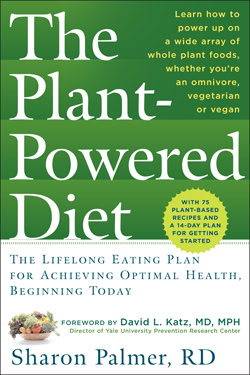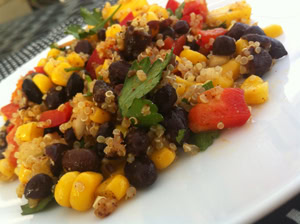
For several decades, Oldways has promoted the health benefits behind traditional diets, which emphasize fruits, vegetables, whole grains, nuts, and seeds. So we’ve been eagerly awaiting the release of The Plant-Powered Diet: The Lifelong Eating Plan for Achieving Optimal Health, Beginning Today, by Sharon Palmer, RD. Sharon merges her passions for writing and food in her trusted and nationally recognized voice, which has brought us hundreds of feature stories about nutrition in the LA Times, Today’s Dietitian, and a host of other publications. As the editor of the award-winning health newsletter, Environmental Nutrition, she has tackled a host of important issues including local and organic foods, eco-friendly culinary practices, sustainability, and food security.
We caught up with Sharon just as her new book was going on sale.
OLDWAYS: The cover of your book says, Learn to power up on a wide array of whole plant foods, whether you’re an omnivore,
vegetarian, or vegan. How do you define a plant-based diet for such a wide range of appetites and food interests
SHARON: A plant-based diet is dedined as one that focuses on plants. So by that definition, anyone can eat a plant-based diet, whether you’re a vegan, vegetarian, or omnivore. By including more whole plant foods and limiting animal foods, you can develop a plant-based eating style that works for you. My book offers a Plant-Powered Diet Spectrum, which allows you to create a personal goal for your eating style.
OLDWAYS: The message that we should all eat more plants seems to be everywhere today. Can you talk a little bit about what is fueling this growing interest
SHARON: The evidence is overwhelming: A plant-based diet promotes a plethora of health benefits that range from reducing rates of chronic diseases like heart disease and type 2 diabetes to promoting a healthy weight, living longer, and functioning better. In addition, it is becoming more clear that our meat loving society is not sustainable for our planet. Animal foods require a great deal of resources to bring to market, compared with plant foods. And people are more concerned about humane practices in modern animal agriculture. All of these issues are feeding into today’s soaring interest in plant-based eating.
OLDWAYS: Is there any way to estimate how many people are changing their eating patterns to include at least one meatless meal per week
SHARON: In my work as a registered dietitian and journalist, I speak to many people who are interested in eating more plant-based meals. In fact, The Vegetarian Resource Group, which analyzed data from a nationwide cross section of 1,010 adults (aged 18 and over), found that 16 percent of respondents reported that they eat vegetarian meals (no meat, fish, seafood, or poultry) more than half of the time, and 17% stated that they eat many vegetarian meals, but less than half the time. Thus, one-third of the population is eating vegetarian meals a significant amount of the time in addition to the number of vegetarians in the country.
OLDWAYS: What are the most common misconceptions about plant-based diets
SHARON: Most people are fearful that you can’t meet your nutritional needs while following a plant-based diet, in particular protein. You can thank the high-protein diet movement for tricking people into thinking that they need so much protein. Actually, our bodies need a modest supply of protein. The Institute of Medicine set the amount at .8 grams of protein per kilogram of body weight. So, if you weigh 150 pounds, that’s 54 grams. You can get that amount of protein in plant foods. All plant foodsexcept refined oil and sugars and alcohol contain measurable amounts of protein. Some are protein superstars, such as beans, lentils, peas, soy, whole grains, nuts, seeds, and even some veggies, such as green leafy vegetables and broccoli. I offer people many solutions in my book to help them get enough protein in their diets.
OLDWAYS: What are some of the pitfalls people have to watch out for on a plant-based diet
SHARON: You need to carefully plan your meals. You can’t just load up on vegetarian junk foods. You need to make all of your foods count towards your nutritional intake, especially if you’re watching your weight. It’s important to get good sources of calcium, vitamin D, protein, and B12 in your diet. I help guide you to optimal nutrition in The Plant-Powered Diet chapter by chapter, as I introduce all of the major foods groups and a daily meal plan, which includes suggested serving sizes. And I encourage you to try to eat mostly whole plant foods, such as beans, lentils, whole grains, tofu, nuts, seeds, fruits, and veggies, rather than rely solely on the prepared veggie foods that are readily available. Some are highly processed and full of additives.
OLDWAYS: Where do you personally it in the eating spectrum omnivore, vegetarian, vegan And how has writing this book changed your thoughts about how you eat
SHARON: I have been a vegetarian or semi-vegetarian my entire life. As a child, my family was semi-vegetarian and rarely ate animal foods. For many years I was a pescatariana vegetarian that includes small amounts of fish. About a year ago, I decided to try veganism and I really liked the impact it had on my own life, as well as the environment and animal welfare. Today, I’m a vegan who eats small amounts of dairy and eggs on occasion, such as when I travel, dine out, or visit friends and family. I can honestly say that I’ve tried every diet level along the Plant-Powered Diet Spectrum at some point of my life. Writing this book has really given me a great personal education and knowledge base on whole plant-based foods. It encouraged me to get to know a range of foods, including tofu in every texture and variety available, tempeh, seitan, nut and seed butters, and every plant-based milk and yogurt imaginable from oats to hemp.
OLDWAYS: When we asked you for a recipe from the book to share with our readers, you suggested the Bean, Quinoa, and Mango Medley below. What is the evolution of this recipe and why do you think of it as a poster child for the book
SHARON: The Bean, Quinoa, and Mango Medley is one of my favorite recipes and one that gets the most compliments. I love it because it includes nearly every food group which I encourage in The Plant-Powered Diet: whole grains, legumes (beans), vegetables, fruits, herbs, spices, and healthy fats all in one dish. You can whip it up in minutes and its delicious served cold or warm. The colors of all of those whole plant foodsjet black beans, golden mango, bright red peppers, deep green cilantro are simply gorgeous. And best of all its delicious! All of those textures, from crunchy to velvety, and flavors citrus, mango, olive, cilantro, and cumin meld together into a really great recipe that can become one of your favorite, go to dishes.
Bean, Quinoa and Mango Medley
From The Plant-Powered Diet (The Experiment, 2012) by Sharon Palmer, RD
The jewel-like black beans gleam in this crunchy, zesty salad, which is packed with disease-fighting anthocyanins, vitamin C, fiber, and lutein. Serve with corn tortillas and vegetable soup for an easy, refreshing meal. And don’t forget to pack up the leftovers for lunch the next day.
Makes 6 servings
Ingredients:
One (15-ounce) can black beans, no salt added, rinsed and drained (see Note)
1 cup cooked quinoa (according to package directions)
1 cup frozen corn
1 small red bell pepper, chopped
1 cup chopped fresh mango
¼ cup finely chopped red onion
½ cup chopped fresh cilantro (or 2 teaspoons dried)
1 small jalapeño pepper, seeded and finely diced
Juice from 1 medium lemon
1 ½ tablespoons extra- virgin olive oil
2 garlic cloves, minced
½ teaspoon ground cumin
½ teaspoon chili powder
¼ teaspoon ground turmeric
Directions:
Mix together the beans, quinoa, corn, pepper, mango, onion, cilantro, and jalapeño in a mixing bowl.
Whisk together the lemon juice, olive oil, garlic, cumin, chili powder, and turmeric in a small bowl. Drizzle over the mixture and toss. Refrigerate until serving time.
Variations: Substitute kidney or pinto beans for the black beans, or use cooked barley, bulgur, rice, or farro instead of the quinoa.
Notes: If you’re in a rush, buy precooked quinoa that comes in handy 1 cup servings.
To substitute home-cooked black beans for the canned beans, cook dried beans and use 1-¾ cups cooked beans in place of the drained, canned beans.
This dish may be served warm by heating all ingredients in a saucepan for three to five minutes, only until heated through.
Nutritional analysis:
Per serving (about 1 cup): Calories: 164, Fat: 4g, Saturated Fat: 1g, Sodium: 93mg, Carbohydrate: 27g, Fiber: 7g, Protein: 6g







Leave a comment